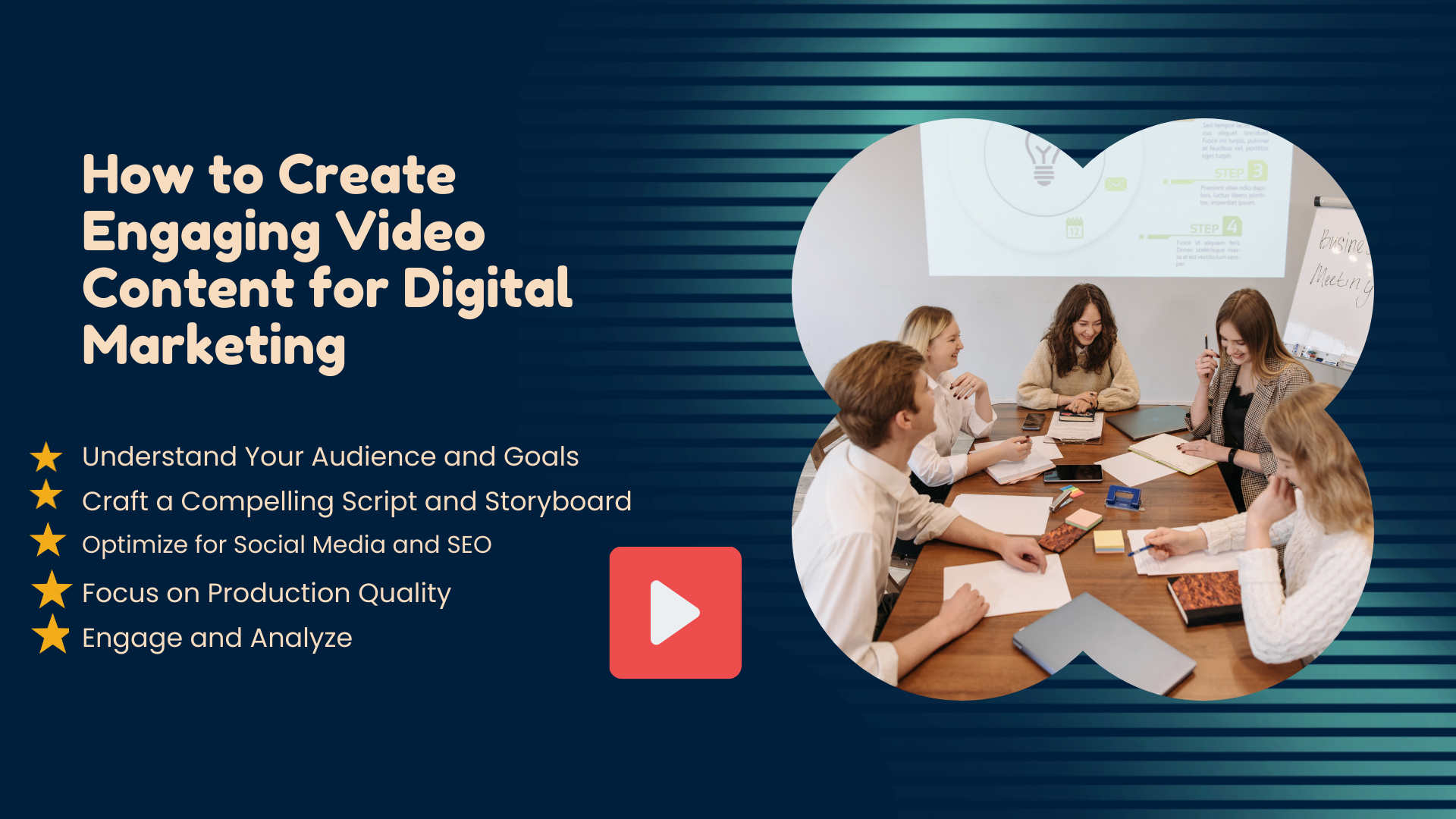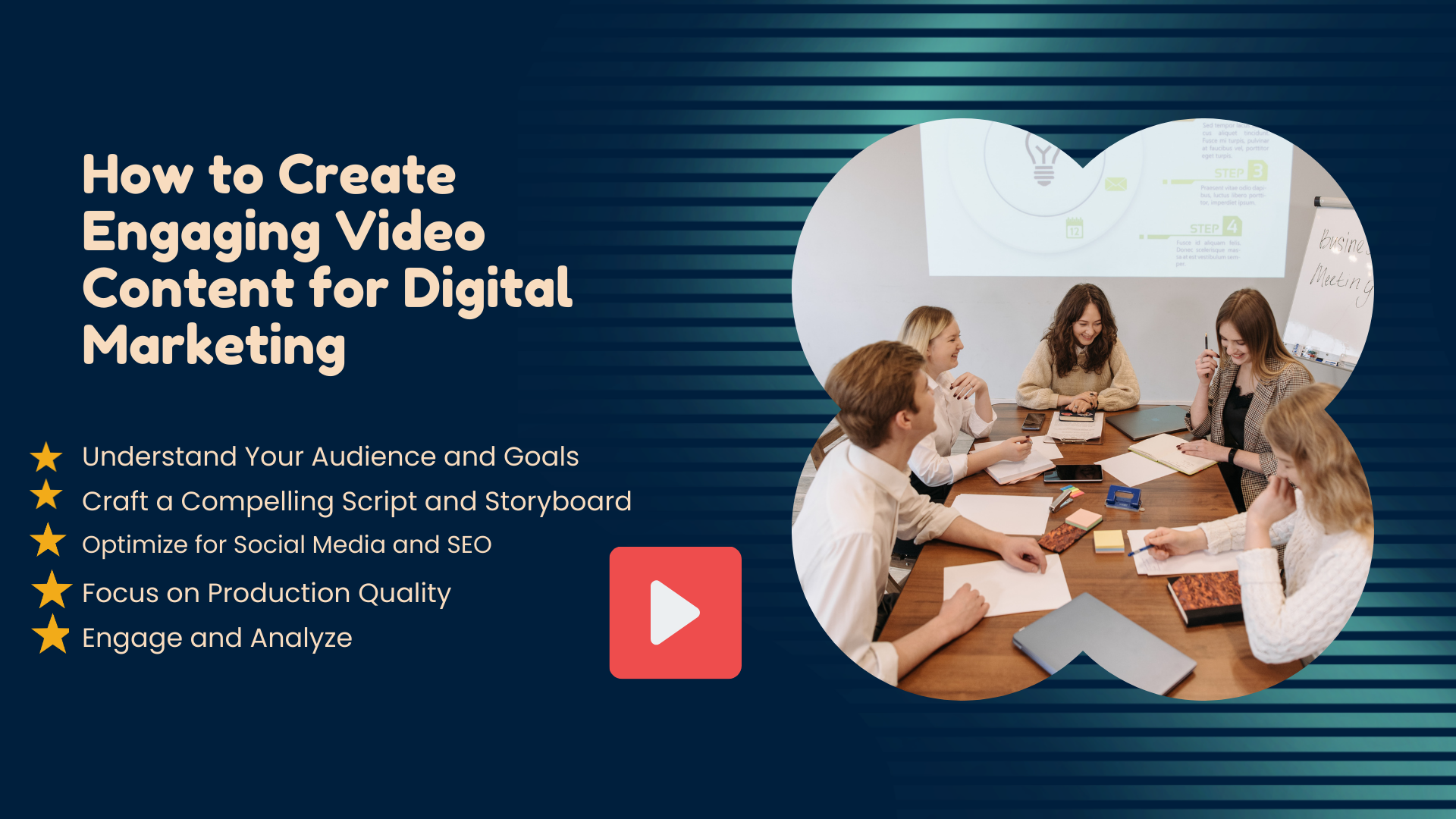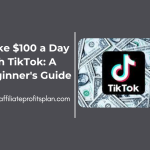Welcome to my article “How to Create Engaging Video Content for Digital Marketing”. In the fast-paced, swipe-left world of digital marketing, video content is no longer just a nice-to-have—it’s your golden ticket to grabbing attention faster than a cat video on a Monday morning. Studies show that 86% of businesses now use video as a marketing tool, and if you’re not in that club yet, let’s just say you’re missing out on a lot more than likes. Whether you’re trying to sell sneakers, SaaS, or sandwiches, video has the magical ability to turn passive scrollers into enthusiastic buyers.
But let’s face it, not all videos are created equal. Some soar with millions of views, while others fizzle out like a sparkler in the rain. What’s the difference? It’s all about engagement. A great video doesn’t just tell a story—it grabs your audience by the eyeballs and refuses to let go (in the nicest way, of course). The good news? You don’t need a Hollywood budget or Steven Spielberg’s address book to make it happen. All you need is a solid plan, a sprinkle of creativity, and maybe a tripod that doesn’t wobble like Jenga on a bad day.
In this guide, we’ll walk you through the essential steps to create video content that not only entertains but also converts. From understanding your audience to optimizing for SEO, and even a few production hacks that won’t break the bank, we’ve got you covered. Ready to dive in? Let’s roll the tape—and no, we won’t ask you to say “action!” unless you really want to.
Access Our Proven Tested Formula for $50-$100 Daily Income – Watch This FREE Video >>

1. Understand Your Audience and Goals
Creating a video without understanding your audience is like baking a cake without knowing who’s eating it. Sure, it might look great, but if your gluten-free, vegan friends are eyeing your triple-chocolate masterpiece with suspicion, you’ve missed the mark. In the world of digital marketing, your audience’s preferences, behaviors, and needs are the recipe for success, and ignoring them is a fast track to obscurity.
First, let’s talk about the *who*. Who are you making this video for? Are they TikTok teens who communicate entirely in memes, or are they B2B professionals who prefer things straight-to-the-point (but secretly enjoy a good dad joke)? Use analytics tools like Google Analytics, social media insights, or audience personas to dig into the nitty-gritty. Find out their demographics, interests, pain points, and even what keeps them up at night (probably your competitors’ videos, but we’ll fix that).
Next, let’s tackle the *why*. Why are you making this video in the first place? Spoiler alert: “Because everyone else is doing it” doesn’t count. Every piece of video content should have a clear goal. Are you trying to boost brand awareness, drive traffic to your website, generate leads, or make your viewers fall in love with your product? Defining your objectives helps you tailor your video’s tone, style, and call-to-action. For example, if you want views and shares, keep it entertaining and emotionally engaging. If conversions are your goal, focus on problem-solving and highlighting value.
Pro tip: Combine these two steps. If your audience is into fitness and your goal is lead generation, why not create a quick workout tutorial featuring your product? It’s a win-win: you give them value, and they might just think of your brand the next time they hit the gym—or their couch.
Understanding your audience and goals isn’t just a box to tick; it’s the foundation of every successful video campaign. Get it right, and you’ll have viewers saying, “This was made just for me!” Get it wrong, and, well, at least your mom will watch.
2. Craft a Compelling Script and Storyboard
Think of your video script as the soul of your content and the storyboard as its roadmap. Without them, you’re like a GPS-less traveler in the middle of nowhere—sure, you *might* get somewhere, but odds are you’ll just end up lost, frustrated, and with way too much footage of your cat “helping.” A compelling script and a well-planned storyboard are the unsung heroes behind every viral hit and high-converting ad.
First, the script. You know that thing people say about first impressions? Turns out, it’s even more important in videos. Your first 5-10 seconds need to *hook* your audience like a cliffhanger at the end of a binge-worthy series. Start with something attention-grabbing—a surprising fact, a bold question, or a funny visual (bonus points if it involves a dancing llama). Keep your language clear, concise, and aligned with your audience’s tone. Selling to Gen Z? Ditch the corporate jargon. Speaking to CEOs? Maybe lay off the memes.
A strong script also follows a simple structure:
Set the stage: What’s the problem or opportunity?
Offer the solution: That’s you, your product, or your service—enter hero music.
End with a bang: Include a call-to-action so irresistible it might as well be wrapped in glitter.
Now, onto the storyboard. Picture this: You’re trying to explain a cool transition idea to your team, but all you have is the phrase “kind of like… zoomy-zoom?” Yeah, no. A storyboard visually maps out each scene, ensuring everyone is on the same page and preventing awkward creative misfires. Sketch out key shots, frame transitions, and note any text overlays or animations. Don’t worry if your drawing skills peak at stick figures—just be clear enough for others to understand the vision.
Pro tip: If you’re short on time (or artistic talent), use tools like Canva’s storyboard templates or dedicated apps like Storyboarder. They make your ideas look polished and save you from trying to explain what a “spiral zoom” looks like with interpretive dance.
Ultimately, your script and storyboard are the glue that hold your video together. They keep you focused, make editing easier, and ensure your audience is captivated from start to finish. Because let’s be real: Nobody clicks “replay” on a chaotic mess of random clips and vague narration. Well, except your cat.
3. Optimize for Social Media and SEO
Creating a great video is only half the battle—getting people to actually *see* It is where the real challenge begins. Think of your video as the life of the party; it’s fun, informative, and has killer dance moves (figuratively speaking). But if no one knows the party exists, your video will be standing awkwardly in the corner, waiting for someone to notice. That’s where social media and SEO optimization come in: they’re the megaphone that makes sure your masterpiece gets the spotlight it deserves.
Tailoring for Social Media Platforms
First, let’s talk about social media. Each platform has its own quirks, trends, and unspoken rules—what works on YouTube might flop on Instagram, and TikTok’s attention span is about as short as a goldfish on espresso.
Access Our Proven Tested Formula for $50-$100 Daily Income – Watch This FREE Video >>
TikTok and Instagram Reels: Keep it snappy (under 60 seconds) and visually engaging. Use trending audio, eye-popping visuals, and captions because, spoiler alert, most people watch without sound.
YouTube: This is where longer-form content thrives. Tutorials, product demos, or storytelling pieces (3-10 minutes) work best. Don’t forget a killer thumbnail—something bright, bold, and just clickbait-y enough without crossing into *cringe*.
LinkedIn: Professional but not boring—think thought leadership with a dash of human interest. Keep it under 2 minutes and add subtitles.
Pro tip: Always upload native videos instead of linking to another platform. Social algorithms love home-grown content and are more likely to bless it with higher reach.
Boosting Your Video SEO
Now, onto SEO—your secret weapon for making sure your video shows up when someone Googles “best marketing tips” or “how to train a llama in 10 days.”
Title: Think clickable *and* keyword-rich. Instead of “Marketing Video Tips,” go for something like “10 Easy Tips to Create Engaging Marketing Videos That Convert.”
Description: Use your main keyword naturally in the first two lines and provide context about your video. Bonus points for adding links to your website or other resources.
Tags: Sprinkle in relevant keywords and phrases your audience might search for. Platforms like YouTube allow up to 500 characters, so don’t hold back.
Thumbnails and Closed Captions: Thumbnails grab attention, while captions make your video accessible to more viewers and improve SEO rankings. Tools like Rev or Otter.ai can help you add captions without pulling your hair out.
Technical Optimization
Fast load times and mobile compatibility are non-negotiables. Use compressed file sizes to avoid buffering (because nothing makes people bail faster than a spinning loading wheel). Test your video on different devices to ensure it looks just as fabulous on a phone as it does on a desktop.
Finally, make engagement easy. Add clear CTAs—“Subscribe now,” “Visit our website,” or “Tag a friend who needs this!”—and include share buttons to encourage your audience to do the heavy lifting. After all, what’s better than free advertising?
Optimize your video like a pro, and it’ll not only find its audience but also make the algorithm gods smile down upon it. Because at the end of the day, your video deserves more than just your mom’s thumbs-up.
4. Focus on Production Quality
Let’s get one thing straight: “production quality” doesn’t mean you need a Hollywood-sized budget or a director yelling “Cut!” every five minutes. But it does mean your video shouldn’t look like it was shot on a potato with a microphone borrowed from the depths of your junk drawer. In today’s competitive digital marketing landscape, viewers expect videos that are visually appealing, audible, and polished—because nothing screams “unprofessional” louder than shaky footage and a soundtrack that sounds like a wind tunnel.
Get the Basics Right: Lights, Camera, Audio!
Lighting: Ever noticed how great lighting can make even the dullest subject look like a rockstar? Invest in affordable lighting equipment or take advantage of natural light (golden hour is your best friend). Avoid harsh shadows unless you’re going for a “film noir” vibe, which, let’s be honest, isn’t ideal for selling toothpaste.
Camera: You don’t need the latest cinema-grade camera—your smartphone probably has a fantastic one built-in. Just make sure it’s steady (use a tripod or gimbal) and set to a high resolution (1080p or higher). Blurry or pixelated footage belongs in the “outtakes” folder.
Audio: Nothing kills a good video faster than bad sound. Invest in a decent microphone—it’s cheaper than you think and makes a world of difference. And remember, background noise should be a subtle hum, not your neighbor’s lawn mower roaring like a dinosaur auditioning for *Jurassic Park*.
Editing: Where the Magic Happens
Editing is like the final polish on your diamond—skip it, and your video will look rough. Use software like Adobe Premiere Pro, Final Cut Pro, or even beginner-friendly tools like iMovie or CapCut to:
– Trim unnecessary fluff (yes, even that 5-second pause where you forgot your lines).
– Add transitions, music, and text overlays to keep things engaging.
Access Our Proven Tested Formula for $50-$100 Daily Income – Watch This FREE Video >>
– Use color grading to make your visuals pop. Nobody wants to watch a video that looks like it was shot through a beige filter.
Pro tip: Keep your edits clean and consistent. Overloading with effects might make it look like your video graduated from the “1998 PowerPoint School of Cool” and not in a good way.
Consistency is Key
Your videos should look like they belong to the same family—no awkward cousins here. Use consistent branding elements like your logo, color schemes, and fonts. Think of this as dressing your video in your brand’s best outfit: recognizable, professional, and 100% you.
Authenticity > Perfection
Now, let’s address the elephant in the room: You don’t *have* to be perfect. In fact, overly polished videos can sometimes come off as cold and corporate. A little authenticity—like a candid blooper or a heartfelt moment—can make your brand more relatable and memorable. Just make sure your “realness” doesn’t extend to bad lighting or audio that sounds like you’re recording from inside a tin can.
In short, production quality is about putting your best foot forward, not renting a private island for your shoot (though if you can, call us—we’re coming along). Nail the basics, sprinkle in some creative flair, and watch as your audience sits up, takes notice, and maybe even clicks *subscribe*. Because a high-quality video doesn’t just look good—it builds trust, tells your story, and keeps viewers coming back for more.
5. Engage and Analyze
Congratulations, your video is live! But don’t pop the champagne just yet—your work isn’t done. Think of your video like a party guest: it doesn’t just need to show up; it needs to mingle, charm everyone, and leave a lasting impression. Engagement and analysis are how you turn a great video into a great *performing* video. Because if your content lands in a digital void where no one clicks, comments, or shares, did it even happen?
How to Spark Engagement
The key to engagement is making your video an interactive experience, not a passive one. You’re not creating a monologue—you’re starting a conversation. Here’s how to keep the chatter going:
Add a Strong Call-to-Action (CTA): Don’t just leave your viewers hanging at the end of the video. Tell them what to do next—visit your website, comment below, share with a friend, or hit that big shiny subscribe button. Make your CTA clear, compelling, and hard to resist (like free pizza, but digital).
Encourage Comments: Ask open-ended questions that invite discussion, like, “What’s your biggest marketing challenge?” or “Which tip was your favorite?” Just be prepared for the one person who says, “None,” and respond graciously anyway.
Use Interactive Features: Platforms like Instagram and YouTube allow polls, clickable links, and end screens. Use them! They’re like digital breadcrumbs that lead viewers straight to your desired outcome.
The Art of Community Management
Engagement doesn’t stop when the video ends—it extends to how you interact with your audience. Reply to comments (even the weird ones), thank people for sharing, and address questions promptly. These little gestures build a loyal following and make your brand feel more human. Bonus points if you can throw in a touch of humor or personality—just maybe avoid trying to be the next stand-up comedian unless you’re really good at it.
Analyze Like a Pro
Now comes the geeky but oh-so-important part: analyzing your video’s performance. Metrics aren’t just numbers—they’re your roadmap to understanding what’s working, what isn’t, and where to go next. Start by tracking these key performance indicators (KPIs):
View Count: How many people watched your video? (Pro tip: If it’s just you refreshing the page, maybe rethink your strategy.)
Watch Time: Did viewers make it through the entire video or bail after the first 10 seconds? A dip halfway might mean your content dragged, or you lost focus.
Engagement Rate: Track likes, shares, comments, and click-throughs. If viewers are interacting, you’re on the right track.
Conversion Rate: If your video had a goal (like sign-ups or purchases), how well did it deliver? This is the ultimate measure of success.
Iterate and Improve
Data without action is like a cake without frosting—what’s the point? Use your insights to tweak your next video. Did a certain CTA flop? Reword it. Did viewers love a particular format? Double down on it. Experiment with length, tone, or even the time of day you post. Every video is a stepping stone to something better, and the only bad mistake is one you didn’t learn from.
Keep the Momentum Going
Finally, keep your audience engaged between videos. Tease upcoming content, repurpose snippets into GIFs or memes, and use behind-the-scenes footage to show your process. Think of it as the Netflix strategy: if you keep them hooked, they’ll keep coming back for more.
Engagement and analysis are where the magic happens. They turn a one-hit-wonder into a sustainable strategy and ensure your videos don’t just exist—they thrive. Because in the world of digital marketing, success isn’t just about creating content; it’s about creating a *connection.* And that’s how you win the game.
Conclusion
So there you have it—the ultimate recipe for creating engaging video content for digital marketing. By now, you’ve learned that a successful video isn’t just about hitting “record” and hoping for the best. It’s about understanding your audience like a mind-reader, crafting scripts that Spielberg would envy, optimizing like an SEO ninja, and sprinkling your masterpiece with just the right amount of production magic. Oh, and don’t forget to engage with your audience and analyze your results, because otherwise, you’re just shouting into the void—and nobody likes an echo.
Access Our Proven Tested Formula for $50-$100 Daily Income – Watch This FREE Video >>
The great thing about video marketing is that it doesn’t require you to be a tech wizard or a millionaire (though a little creativity and coffee go a long way). Whether you’re a small business owner, a marketing pro, or someone who just really loves talking to a camera, there’s room for you to shine. Start small, experiment often, and remember: not every video has to go viral to be valuable. Sometimes, all it takes is reaching the right audience at the right time to make a big impact.
And hey, don’t be afraid to have fun with it! Video content is your chance to show off your brand’s personality, connect with your audience, and maybe even make them laugh (dad jokes optional). Whether your first attempt is a smash hit or a lovable learning experience, each video brings you closer to mastering the art of digital storytelling.
So, what are you waiting for? Grab your camera, jot down those ideas, and start creating. Who knows? Your next video might just be the one that makes your audience hit “share” faster than they can say “algorithm-approved.” Now, go forth and make video magic! Thanks a lot for reading my article on “How to Create Engaging Video Content for Digital Marketing“ till the end. Hope you’ve helped. See you with another article.










